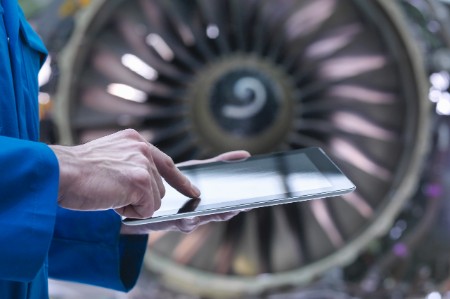An Australian aerospace company designed a wearable-assisted system that leverages augmented reality to connect on-the-ground technicians with experts anywhere in the world to solve maintenance challenges in real time. The wearable system will reduce repair down time of grounded aircraft as it removes the need for specialists to travel.
Blockchain
Blockchain enables OEMs to monitor and collaborate with thousands of suppliers and customers for successful production and delivery of A&D systems. Service providers for governments can use blockchain to secure their transaction records and protect sensitive information from being mishandled or tampered with.
Cloud, mobile and analytics
Cloud, mobile and analytics enable suppliers to act efficiently and connect with OEMs suppliers to optimize the supply chain. OEMs use data analytics to provide predictive maintenance, track performance and also optimize shop floor processes. MRO operators use advanced analytics tools to improve work schedule planning and optimize maintenance procedures.
Cybersecurity
By adhering to standards and protocols, suppliers can create an infrastructure to prevent leakage of proprietary data and ensure compliance and cybersecurity. A&D OEMs also monitor the cybersecurity capabilities of their suppliers to ensure an environment of trust.
Service providers for governments along with leading OEMs are eyeing opportunities to scale up their cybersecurity capabilities and provide cybersecurity solutions to the governments.
Internet of Things (IoT) and sensors
IoT and sensors enable collection and analysis of vast amount of operational data from shop floor assets and critical A&D components. This data is leveraged to track and predict maintenance needs of critical assets and prevent unscheduled maintenance stoppages.
IoT and sensors enable MRO operators to avoid time-consuming disassemblies during inspections and make targeted maintenance decisions. Furthermore, with OEMs eyeing larger share in MRO operations, IoT is enabling them to build intelligence into components and devices used in MRO processes using complex and sensitive flight data.
Distributed intelligence of sensor-connected assets helps production managers make the right decisions on the shop floor. Monitoring and analysis of critical parts can be used to improve machine productivity and reliability.
A US-based aircraft engine manufacturer has over 5,000 sensors installed on the aircraft powered by its next-generation engines. These sensors are connected using IoT and generate up to 10 GB of data per second. The engine manufacturers can use this data to predict engine life, improve fuel efficiency, and reduce noise and emissions.
Five major forces fueling digital transformation in A&D
1. Enhancing customer experience and involvement.
A&D companies must ensure that all their business decisions are aligned to the key strategies and changing needs of their key customers. They should closely collaborate with customers in R&D and product development and use technology-enabled simulation to facilitate better procurement decisions.
2. Redefining products and services.
Product and service portfolios should be aligned to the industry trends. Companies should offer services with their products, focusing on long-term service agreements. Technology should drive collaboration and conceptualization. Value-add solutions, enabled by data captured through sensors, should be provided.
3. Digitalizing business operations.
Use an omni-channel strategy to sell products and services, as well as smart contracts that leverage the blockchain. Offer cloud-based solutions providing decision support. Data analytics can be deployed in demand planning, inventory management, predictive maintenance product quality and customer satisfaction.
4. Developing workforce of the future.
Companies must develop an agile workforce that is capable enough to adapt the emerging digital technologies.
5. Building a value chain ecosystem.
The A&D value chain of the future will be an effective collaboration between manufacturers, suppliers and customers. Driven by technology and customization, 3D printing will reshape the A&D supply chain. Suppliers will collaborate in product development, planning and services. And new revenue-risk sharing models will incentivize suppliers to bring in product innovation.
Summary
A&D companies can no longer afford to focus solely on manufacturing and delivering products. They need to be holistic solution providers for their customers with high focus on innovation and agility to quickly adapt to changing preferences.


